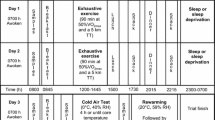Summary
Although it is well established in animals that acute cold exposure markedly increases the oxidation of energy substrates, the absolute quality and quantity of substrate oxidation is poorly understood in humans. This study compared the rates of substrate utilization in seven healthy young men exposed to both the warm (control exposure at 29° C; semi-nude, 14 h fasted) and to the cold for 2 h (10° C, 1 m·s−1 wind velocity). Substrate utilization was calculated using indirect calorimetry and the nonprotein respiratory exchange ratio, which was derived from the urinary urea nitrogen output. Cold exposure induced a 3.1±0.2° C drop in mean body temperature and a body heat debt of 825.9±63.3 kJ (p<0.01). These parameters remained essentially unchanged in the warm. Cold exposure elevated the 2 h energy expenditure 2.46-fold in comparison to the warm (p<0.01). This cold-induced thermogenesis was accompanied by increases of 588% in carbohydrate oxidation (p<0.01) and 63% in fat oxidation (p<0.05), whereas protein oxidation remained unchanged. Although the greatest proportion of the energy expenditure in the warm was derived from lipid (59%), carbohydrate oxidation represented the major fuel for thermogenesis in the cold, since it accounted for 51% of the corresponding total energy expenditure. The results demonstrate that cold exposure causes a much greater increase in the utilization of carbohydrate than lipid. It is suggested that these substrates are directly utilized for thermogenesis in the shivering skeletal muscles.
Similar content being viewed by others
References
Acheson KJ, Zahorska-Markiewicz B, Pittet P, Anantharaman K, Jequier E (1980) Caffeine and coffee: their influence on metabolic rate and substrate utilization in normal weight and obese individuals. Am J Clin Nutr 33:989–997
Acheson KJ, Schutz Y, Bessard T, Ravussin E, Jequier E, Flatt JP (1984) Nutritional influences on lipogenesis and thermogenesis after a carbohydrate meal. Am J Physiol [Endocrinology Metab] 246:E62-E70
Alexander G (1979) Cold thermogenesis. In: Robertshaw D (ed) International review of physiology. Environmental physiology III, vol 20. University Park Press, Baltimore, MD, pp 43–155
Burton AC, Edholm OG (1969) Man in a Cold Environment. Hafner Publishing Co, New York, NY, pp 38–42
Buskirk ER, Thompson RH, Whedon GD (1963) Metabolic response to cold air in men and women in relation to total body fat content. J Appl Physiol 18:603–612
Depocas F, Masironi R (1960) Glucose as fuel for thermogenesis. Am J Physiol 199:1051–1058
Folk GE (1974) Textbook of Environmental Physiology. Lea and Febiger, Philadelphia, PA, pp 98–215
Glickman N, Mitchell HH, Keeton RW, Lambert EH (1967) Shivering and heat production in men exposed to intense cold. J Appl Physiol 22:1–8
Goodenough RD, Royle GT, Nadek ER, Wolfe MH, Wolfe RR (1982) Leucine and urea metabolism in acute human cold exposure. J Appl Physiol 53:367–372
Hardy JD, Dubois EF (1941) The significance of the average temperature of the skin. In: American Institute of Physics. Temperature, its measurement and control in the science and industry. Reinhold, New York, NY, pp 537–543
Himms-Hagen J (1972) Lipid metabolism during cold exposure and cold acclimation. Lipids 7:310–320
Hurley BF, Haynes EM (1982) The effects of rest and exercise in the cold on substrate mobilization and utilization. Aviat Sp Environ Med 53:1193–1197
Issekutz B, Rodahl K, Birkhead NC (1962) Effect of severe cold stress on the nitrogen balance of men under different dietary conditions. J Nutr 78:189–197
Jansson E (1982) On the significance of the RER after different diets during exercise in man. Act Physiol Scand 114:103–110
Jequier E (1980) Metabolisme energetique. Encyclopedie medico-chirurgicale. Nutrition 10371 A 10 (Paris) 1–12
LeBlanc J (1975) Man in the cold. Charles C. Thomas Publishers Inc. Springfield, IL, p 63–84
Lusk G (1928) The elements of the Science of nutrition. Saunders, Philadelphia, PA, pp 64–67
Mager M, Robinson SM (1969) Substrate mobilization and utilization in fasting men during cold exposure. Bull New Jersy Acad Sci [Symposium issue]:26–32
McGilvery RW (1983) Biochemistry, a functional approach. WB Saunders, Philadelphia, PA, pp 786–816
Minaire Y, Forichon J, Jomain MJ, Dallevet G (1981) Independence of the circulating insulin levels of the increased glucose turnover in shivering dogs. Experientia 37:745–747
Newstead CG (1987) The relationship between ventilation and oxygen consumption in man is the same during both moderate exercise and shivering. J Physiol 383:455–459
Paul P, Holmes WL (1973) Free fatty acid metabolism during stress: exercise, acute cold exposure and anaphylactic shock. Lipids 8:142–150
Ravussin E, Schutz T, Acheson KJ, Dusmet M, Bourquin L, Jequier E (1985) Short-term mixed diet overfeeding in man: no evidence for “luxusconsumption”. Am J Physiol 249 [Endocrinol Metab 12]:E470-E477
Seitz HJ, Krone W, Wilke H, Tarnowski W (1981) Rapid rise in plasma glucagon induced by acute cold exposure in man and rat. Pflügers Arch 389:115–120
Spurr GB, Hutt BK, Horvath SM (1957) Shivering, oxygen consumption and body temperatures in acute exposure of men to two different cold environments. J Appl Physiol 11:58–64
Thompson GE (1977) Physiological effect of cold exposure. In: Robertshaw D (ed) International review of physiology II, vol 15. University Press, Baltimore, MD, pp 29–69
Timmons BA, Araujo J, Thomas TR (1985) Fat utilization enhanced by exercise in a cold environment. Med Sci Sp Exercise 17:673–678
Vallerand AL, Lupien J, Bukowiecki LJ (1983) Interactions of cold exposure and starvation on glucose tolerance and insulin response. Am J Physiol 245 [Endocrinol Metab 8]:E575-E581
Vallerand AL, Perusse F, Bukowiecki LJ (1987) Cold exposure potentiates the effect of insulin on in vivo glucose uptake. Am J Physiol 253 [Endocrinol Metab 16]:E179-E186
Vallerand AL, Frim J, Kavanagh MF (1988) Plasma glucose and insulin responses to oral and intravenous glucose in cold-exposed men. J Appl Physiol 65:2395–2399
Wilson O, Laurell S, Tibbling G (1969) Effect of acute cold exposure on blood lipids in man. Fed Proc 28:1209–1215
Author information
Authors and Affiliations
Additional information
This is DCIEM paper no. 89-P-/6
Rights and permissions
About this article
Cite this article
Vallerand, A.L., Jacobs, I. Rates of energy substrates utilization during human cold exposure. Europ. J. Appl. Physiol. 58, 873–878 (1989). https://doi.org/10.1007/BF02332221
Accepted:
Issue Date:
DOI: https://doi.org/10.1007/BF02332221




